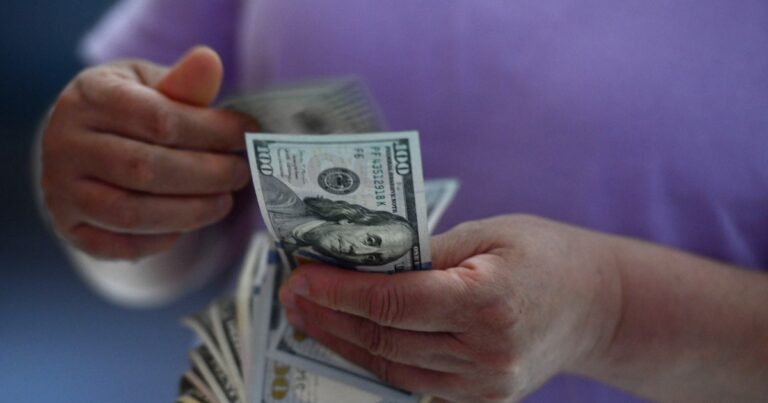President Donald Trump wants the U.S. to increase its exports and lower its imports. Thanks to a historic decline in the value of the U.S. dollar, he may get his wish — but at a cost he may not have anticipated.
Over the past six months, the dollar has declined more than 10% compared with a basket of currencies from the U.S.’ major trading partners — something it has not done since 1973. Today, it sits at a three-year low.
The simplest explanation for the decline is that global investors now expect the U.S. economy to no longer outperform the rest of the world as a result of Trump’s tariffs and worsening fiscal issues. Even with U.S. stocks returning to record highs, the return on other countries’ equities has been even stronger. Meanwhile the return on lending to the U.S. is expected to decline as growth here slows.
It wasn’t supposed to be this way. Many, including members of Trump’s own Cabinet, assumed his tariffs strategy would strengthen the value of the dollar relative to foreign currencies. The thinking behind it was that as American consumers began to purchase fewer foreign goods, those other countries’ currencies would weaken relative to the dollar.
Instead, the opposite has occurred. U.S. growth prospects have weakened — in part because of Trump’s tariffs. That has made U.S. debt relatively less attractive for foreign investors, especially compared with the returns on lending to other countries, like Germany and Japan, that are now expected to experience higher growth.
In theory, the advantage of a weaker U.S. dollar is that it makes goods produced in the U.S. more attractive to foreign markets.
Yet it is too soon to say whether that is occurring. In anticipation of Trump’s tariffs, U.S. firms massively increased their imports in the first three months of this year to avoid paying the new duties, and it will be weeks before second-quarter data is released.
Even then, that data will likely only show a snapback effect from the first quarter’s upswing. And while Trump has announced a flurry of new investments designed to beef up U.S. production capacity, many of those endeavors are months or even years from coming on line.
One obvious effect of a weakening U.S. dollar is that it becomes more expensive for Americans to go to popular destinations abroad, since the greenback will be worth less than local currencies. In essence, your money won’t stretch as far. Of course, such excursions tend to be taken largely by travelers who are less worried about increased costs.
At home, a bigger concern is inflation, and lost purchasing power for U.S. consumers and businesses, who still remain heavily reliant on imports. Until America is able to sustainably produce more goods on its own at higher volumes, purchasing power will decline as it becomes relatively more expensive to import goods from abroad.
In the meantime, analysts say, a more alarming trend may be taking root: Foreigners are no longer buying U.S. financial assets, like stocks and bonds, at the levels that have allowed the U.S. to finance its trade deficit in the first place. Although U.S. stocks have returned to record levels, on a relative basis, they’ve underperformed their counterparts in Europe and elsewhere.
“It’s often forgotten that the U.S. is not only reliant on foreigners’ goods, but we’re also meaningfully reliant on foreign capital to support our financial markets,” said Bob Elliott, chief investment officer at Unlimited Funds financial group. “Your bonds are bought by European investors, your stock is bought by European investors — that is making you feel wealthier.”
A weaker dollar, he said, could weigh on foreign investors’ willingness to buy U.S. financial assets, “which are so critical to supporting U.S. household balance sheets.”
“An emerging theme in asset management is the rotation out of US assets into Europe as investors seek non-US exposure,” Bank of America’s Hubert Lam and Christiane Holstein said in a late June note. “Sentiment toward US markets has turned negative due to mounting concerns over protectionist trade measures, abrupt policy shifts, a rising deficit, and a proposal for taxes targeting foreign investors in the US.”
“As such, investors are starting to diversify out of the US in both public and private markets,” they said.
The Bank of America analysts added that many international investors are reallocating their investment choices to their home markets, especially in Europe, “for policy stability” and “patriotic” reasons.
On the other hand, a handful of analysts say fears of continued U.S. dollar weakness are overblown, and that U.S. economic exceptionalism will ultimately prevail. The U.S. has always outperformed on growth thanks to its dynamic markets and pro-growth regulations, and Trump’s bill cementing massive tax cuts — plus initial data showing the U.S. labor market remained relatively sturdy in June — have already provided a brief rally in the dollar’s value this week.
But assuming U.S. growth does weaken, the Federal Reserve will likely start cutting interest rates, further making U.S. financial assets less attractive to outside investors. That will cause the value of the dollar to decline even further, making it even more expensive to buy goods from abroad.
“It’s a doom loop,” said Danny Dayan, an investor and former hedge fund manager.
“So far, the inflation data have been quite benign,” Dayan said. “But we know tariffs will raise prices to some degree.” A weakening dollar will only contribute to accelerating price growth, he said.
